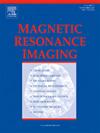定量敏感性作图和弥散峰度成像的直方图分析,用于预测2021年WHO成人型弥漫性胶质瘤的分级。
IF 2
4区 医学
Q2 RADIOLOGY, NUCLEAR MEDICINE & MEDICAL IMAGING
引用次数: 0
摘要
目的:评价定量易感图谱(QSM)和弥散峰度成像(DKI)直方图特征在提高2021年世界卫生组织中枢神经系统肿瘤分类(WHO CNS 5)成人型弥漫性胶质瘤分级准确性中的作用,并与常规成像序列相结合。方法:对62例患者进行回顾性分析。提取肿瘤实质中QSM、DKI、CE-T1WI、T2FLAIR的直方图特征。使用独立t检验和Mann-Whitney U检验比较2/3级和4级胶质瘤的差异。模型的评价包括受试者工作特征(ROC)曲线、5重交叉验证、模态图构建和校准曲线分析。采用Kaplan-Meier生存分析评估两组患者的预后差异。结果:采用QSM平均绝对偏差(MAD)和相对平均峰度第90百分位(rMK P90)构建功能成像模型(AUC = 0.892),采用CE-T1WI稳健平均绝对偏差(RMAD)和T2FLAIR最大值构建常规成像模型(AUC = 0.776)。CE-T1WI RMAD、QSM MAD和rMK P90的成像组合模型的AUC为0.936。在临床因素中,年龄在两组间差异有统计学意义,AUC为0.769。影像模型与年龄相结合的综合模型AUC最高,为0.949。经5倍内交叉验证,平均AUC为0.944。生存分析显示2/3级和4级胶质瘤之间存在显著差异。结论:QSM和DKI的直方图特征可以补充常规序列,提高成人型弥漫性胶质瘤分级的诊断效能。本文章由计算机程序翻译,如有差异,请以英文原文为准。
Histogram analysis of quantitative susceptibility mapping and diffusion kurtosis imaging for the grading prediction of 2021 WHO adult-type diffuse gliomas
Objectives
To evaluate the role of quantitative susceptibility mapping (QSM) and diffusion kurtosis imaging (DKI) histogram features in improving the 2021 World Health Organization Classification of Central Nervous System Tumors (WHO CNS 5) grading accuracy for adult-type diffuse gliomas when combined with conventional imaging sequences.
Methods
A total of 62 patients were retrospectively collected. Histogram features of QSM, DKI, CE-T1WI, T2FLAIR were extracted from tumor parenchyma. Independent t-tests and Mann-Whitney U tests were used to compare differences between grade 2/3 and grade 4 gliomas. The evaluation of the model included receiver operating characteristic (ROC) curves, 5-fold cross-validation, nomogram construction, and calibration curve analysis. Prognostic differences between two groups were assessed using Kaplan-Meier survival analysis.
Results
The functional imaging model (AUC = 0.892) was constructed using QSM mean absolute deviation (MAD) and relative mean kurtosis 90th percentile (rMK P90), while the conventional imaging model (AUC = 0.776) was built using CE-T1WI robust mean absolute deviation (RMAD) and T2FLAIR maximum. The imaging combined model, incorporating CE-T1WI RMAD, QSM MAD, and rMK P90, achieved an AUC of 0.936. Among the clinical factors, age showed a statistically significant difference between the two groups, with an AUC of 0.769. The integrated model combining the imaging model and age achieved the highest AUC of 0.949. The 5-fold internal cross validation showed that the average AUC was 0.944. Survival analysis revealed a significant difference between grade 2/3 and grade 4 gliomas.
Conclusion
Histogram features of QSM and DKI can complement conventional sequences, enhancing the diagnostic performance for adult-type diffuse gliomas grading.
求助全文
通过发布文献求助,成功后即可免费获取论文全文。
去求助
来源期刊

Magnetic resonance imaging
医学-核医学
CiteScore
4.70
自引率
4.00%
发文量
194
审稿时长
83 days
期刊介绍:
Magnetic Resonance Imaging (MRI) is the first international multidisciplinary journal encompassing physical, life, and clinical science investigations as they relate to the development and use of magnetic resonance imaging. MRI is dedicated to both basic research, technological innovation and applications, providing a single forum for communication among radiologists, physicists, chemists, biochemists, biologists, engineers, internists, pathologists, physiologists, computer scientists, and mathematicians.
 求助内容:
求助内容: 应助结果提醒方式:
应助结果提醒方式:


